Thursday, March 25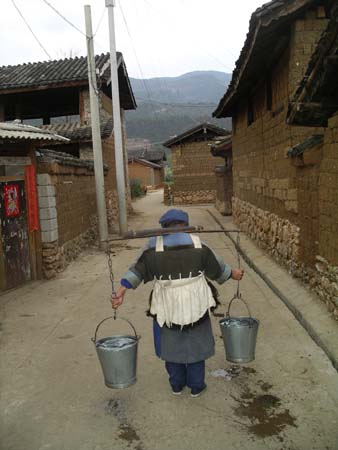
Steve: Today was our opportunity to see and learn more
about China's Naxi ethnic minority, and we had planned visits to two Naxi
villages. Leaving Lijiang at 9:00 this morning, we found its narrow streets
to be already packed with tourists. Panjingmieg told us that before 1996,
very few tourists came here. In 1996 Lijiang suffered a terrible earthquake
that destroyed much of the town and also killed over 300 people (100 of them
right here in the old city where we are staying). Because of international
assistance (including significant contributions from America), the Chinese
were able to rebuild Lijiang within one year and did so with the definite
intent of attracting tourists. Lijiang was unknown in China as a tourist destination
before 1996, but ironically, the media attention from the earthquake resulted
in this beco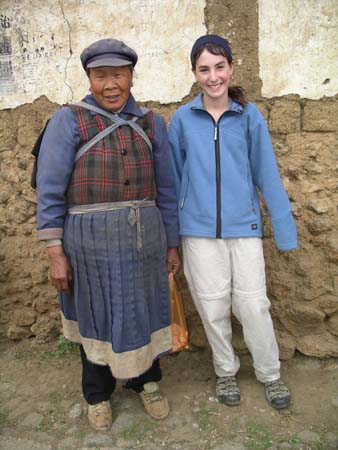 ming
one of China's most popular vacation spots (especially for city residents
looking to escape to the peaceful mountains).
ming
one of China's most popular vacation spots (especially for city residents
looking to escape to the peaceful mountains).
As we squeezed between tour groups on our way out of the old city, we again
saw several traditionally dressed women walking on the streets and wondered
how they must feel about the huge number of tourists who descend on Lijiang
every single day. Only eight years ago, the streets were all quiet - what
a major change for the people who live here. Of course, the economical benefits
have certainly been a plus, and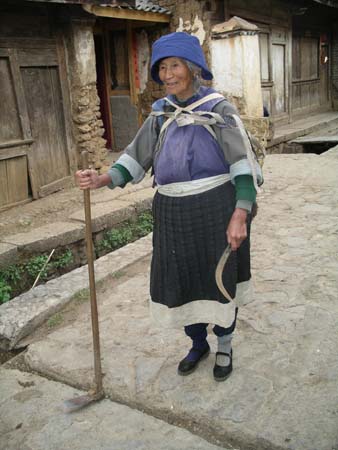 many of the older people now can support themselves through small shops in
town instead of having to work in the fields.
many of the older people now can support themselves through small shops in
town instead of having to work in the fields.
Our first stop was at a village called Baisha, just north of Lijiang. This
is a very quiet village, and we were delighted to be able to walk streets
where the only people we saw were local residents. Most of them were older
women wearing traditional blue clothing, and many were carrying loads of water,
produce or clothes. These women were all extr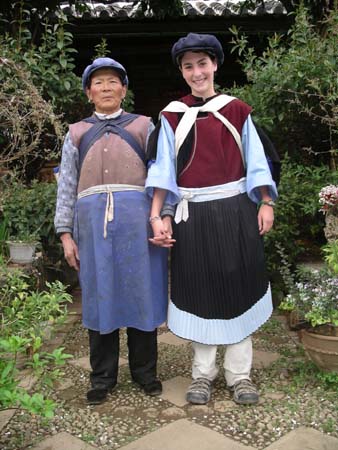 emely
friendly, and we engaged several in conversation. One woman was 85 years old,
and still works in the fields; we couldn't believe how hard the people work,
especially at these ages. Interestingly, we saw very few men. Those we did
see were playing mahjong, sitting on the streets or caring for their grandchildren.
Again, in the Naxi culture, the women are the ones who do the work to support
their families.
emely
friendly, and we engaged several in conversation. One woman was 85 years old,
and still works in the fields; we couldn't believe how hard the people work,
especially at these ages. Interestingly, we saw very few men. Those we did
see were playing mahjong, sitting on the streets or caring for their grandchildren.
Again, in the Naxi culture, the women are the ones who do the work to support
their families.
One older woman that we met on the street showed us some pictures and insisted
that we come to her home - we agreed. When we arrived, she took us through
her courtyard, complete with a beautiful garden, and asked us to sit, feeding
us nuts and offering tea. Although she didn't speak English, she kept pointing
at Katie and saying "Beautiful!" Then she pulled out some  traditional
Naxi clothing that we learned is worn by women at weddings, and asked Katie
to try it all on. At this point we suspected that she wanted to sell us something,
but Panjingmieg said this wasn't the case - so we weren't sure exactly what
was going on…
traditional
Naxi clothing that we learned is worn by women at weddings, and asked Katie
to try it all on. At this point we suspected that she wanted to sell us something,
but Panjingmieg said this wasn't the case - so we weren't sure exactly what
was going on…
Katie looked very cute all dressed up as a Naxi woman, and we had fun taking
pictures. The woman also gave us a quick tour of 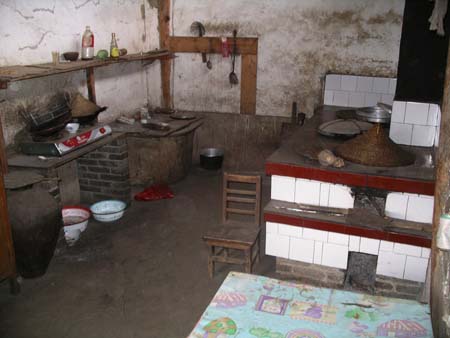 her
home, including her small kitchen where she also keeps a shrine in memory
of her late husband. Finally, when we got ready to leave, she gave us a large
round pear as a gift, and handed us a visitor guestbook to sign. We thought
this was all very unusual, but things became a little clearer as we skimmed
the prior entries in the book, many of which are in English. What we learned
is that this woman loves to invite people into her home, simply to be friendly
(and also probably to relieve some of her loneliness since she lives alone).
her
home, including her small kitchen where she also keeps a shrine in memory
of her late husband. Finally, when we got ready to leave, she gave us a large
round pear as a gift, and handed us a visitor guestbook to sign. We thought
this was all very unusual, but things became a little clearer as we skimmed
the prior entries in the book, many of which are in English. What we learned
is that this woman loves to invite people into her home, simply to be friendly
(and also probably to relieve some of her loneliness since she lives alone).
 What was funny was that the notes described exactly the same experience that
we had, saying things like "You'll probably wonder what this woman wants
from you, especially after she serves you nuts and dresses you up in Naxi
clothing. But rest assured, all she's doing is displaying the wonderful hospitality
that the Naxi are known for. She's a wonderful woman - enjoy your time with
her!" One of the notes went on to say "Let me warn you - don't eat
the pear that she gives you. It is rock-hard and doesn't taste very good!"
We all got a big laugh reading these entries, and thinking about all the people
who had gone through this same experience, wondering the exact same things
the whole time. In fact, one of the entries was from an American couple who
had been h
What was funny was that the notes described exactly the same experience that
we had, saying things like "You'll probably wonder what this woman wants
from you, especially after she serves you nuts and dresses you up in Naxi
clothing. But rest assured, all she's doing is displaying the wonderful hospitality
that the Naxi are known for. She's a wonderful woman - enjoy your time with
her!" One of the notes went on to say "Let me warn you - don't eat
the pear that she gives you. It is rock-hard and doesn't taste very good!"
We all got a big laugh reading these entries, and thinking about all the people
who had gone through this same experience, wondering the exact same things
the whole time. In fact, one of the entries was from an American couple who
had been h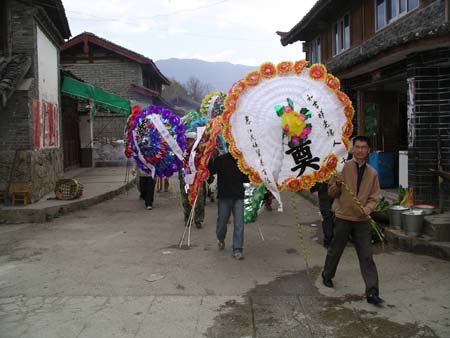 ere
earlier this morning!
ere
earlier this morning!
We continued walking through the village, admiring many interesting people
and taking as many photographs as we could. At one point we ran into a funeral
procession, complete with men (no women allowed) carrying large colorful decorations.
At each intersection, loud firecrackers were set off - the Naxis believe that
permission from the gods is required before dead bodies can pass over bridges
or through intersections. This is their way of alerting the gods that the
dead body is passing. The body was not in a coffin - it was carried on a wooden
stretcher and covered with cloth.
We then stopped by the home of Dr. Ho, who has become internationally famous for his herbal medicine practice. Outside his home is a huge display of international publications that feature pictures and articles about Dr. Ho. Our Lonely Planet book tells the story of how this unknown doctor became bigger than life due to a travel writer (Bruce Chatwin) who featured him in his work. All of a sudden, Dr. Ho became included by virtually all travel books that covered Lijiang, and publications all over the world started to write about him. Wow!
Dr. Ho was not here today, but his son, also a doctor spotted us outside
his office home and quickly invited us inside. What a character! This man
kept handing us things to read about Dr. Ho, and couldn't stop talking about
his herbal medicine practice and all the people he's cured. He showed us notes
from the Mayo Clinic describing patients who had been miraculously cured here,
asking Dr. Ho for his herbal recipes. He served us some of his special tea,
describing its wonderful healing properties. He  also
told us about how Dr. Ho often refuses to accept payments from his patients,
preferring to focus entirely on bringing them to good health.
also
told us about how Dr. Ho often refuses to accept payments from his patients,
preferring to focus entirely on bringing them to good health.
All along, we thought this was part of a huge sale pitch, and we were waiting for the request for money (to support his medical practice) that never came. Panjingmieg told us that this man simply likes to tell people about all they do, and hopes that based on what we learned today we'll spread the word to others. Finally, we had to excuse ourselves (he would have gone on forever!), and we left graciously thanking him for the tea and his hospitality. What a strange experience this was…
Our final stop in Baisha was to see some religious frescoes that date back 500 years from the Ming Dynasty. It was interesting to see the different religions depicted here, including Buddhism, Hinduism and Taoism.
It occurred to us before we left Baisha that this is probably how Lijiang
appeared  before
the earthquake and subsequent rebuilding and transformation into a tourist
destination. The architecture is the same, but the buildings lack the flare
and color that is so prominent in Lijiang. Panjingmieg confirmed that in fact,
Lijiang did look like this before 1996. She also acknowledged that foreign
tourists much prefer the small villages like Baisha, while the Chinese tourists
spend all their time in Lijiang. Fortunately, we have found very few foreign
tourists in the Yu
before
the earthquake and subsequent rebuilding and transformation into a tourist
destination. The architecture is the same, but the buildings lack the flare
and color that is so prominent in Lijiang. Panjingmieg confirmed that in fact,
Lijiang did look like this before 1996. She also acknowledged that foreign
tourists much prefer the small villages like Baisha, while the Chinese tourists
spend all their time in Lijiang. Fortunately, we have found very few foreign
tourists in the Yu nnan
province, so we have been able to escape to delightful places like Baisha.
nnan
province, so we have been able to escape to delightful places like Baisha.
Before heading back to Lijiang for lunch, we visited the colorful Jade Peak
Lama Temple and learned a bit about Tibetan Buddhism. It was also fun to watch
Chinese tourists line up to buy huge incense sticks that they then lit and
placed in front of the temple - we've never seen so much incense burning at
once! We also stopped at the 10,000 Camellia Flower Tree. It's 500 years old
and actually  consists
of two trees planted together, symbolizing a bonded man and woman. We learned
that the government wanted to cut the trees down during the Cultural Revolution,
but the l
consists
of two trees planted together, symbolizing a bonded man and woman. We learned
that the government wanted to cut the trees down during the Cultural Revolution,
but the l ocal
Lamas (Tibetan monks) worked successfully to protect the tree.
ocal
Lamas (Tibetan monks) worked successfully to protect the tree.
After much effort, we successfully arranged to have lunch at another small,
local restaurant (instead of the originally-planned tourist meal in a hotel).
This turned into another wonderful experience, and it was funny to see the
local people staring and smiling at us as we devoured another "hot pot"
(a mixture of pork, vegetables and noodles that's brought bubbling and steaming
to your table). We also had several tasty vegetable dishes and rice. Along
with drinks, the cost of our lunch was $7.50 - relatively expensive compared
to some others we've had here!
This afternoon we visited Shu He, another small Naxi village. The approach
to the village was beautiful, and we stopped to take pictures of how the village
sits at the base of mountains and is surrounded by farmland and fields of
yellow canola flowers. Similar to Baisha, this village is filled with friendly,
interesting people and we enjoyed simply walking the streets and stopping
in homes. We watched as women washed  clothes
and food in the canals that are fed with clear water from the mountains. The
village is dotted with well-maintained flower and vegetable gardens, and is
very charming. We did note that there was a large amount of construction happening
here, and we wondered whether Shu He is headed for an influx of tourism similar
to what we've seen in so many other places. Panjingmieg did
clothes
and food in the canals that are fed with clear water from the mountains. The
village is dotted with well-maintained flower and vegetable gardens, and is
very charming. We did note that there was a large amount of construction happening
here, and we wondered whether Shu He is headed for an influx of tourism similar
to what we've seen in so many other places. Panjingmieg did  tell
us that more and more tourists come here, and we saw some evidence of that
today.
tell
us that more and more tourists come here, and we saw some evidence of that
today.
We stopped in the local hospital, which has actually been built by a Chicago
physician who secured funding in America and established this center. This
was by far the nicest medical facility we have seen in Asia.
We also visited a large primary school in Shu He, one that has been funded through international contributions. We had fun playing and interacting with the children during their recess, and also stopped in a first grade classroom. The class was very large (38 children), and the teacher told us that this is actually somewhat smaller than most classrooms here.
Dinner tonight was in a small local restaurant near our hotel. We had a great meal of rice noodles with beef, fried pork with onions, fried spinach (one of our favorite dishes), Chinese dumplings and fried mushrooms. It was all great!
Tomorrow morning we hope to explore Lijiang before the streets become busy. In the afternoon we're visiting another Naxi village and are going to a local park.

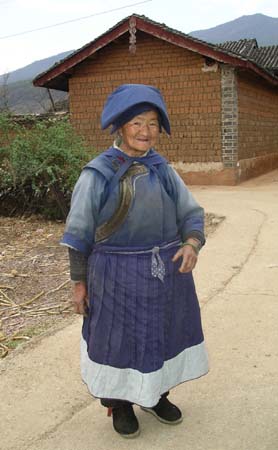


David's Daily Dump: Unique Chinese Customs. During our stay here in China we have observed some very unique customs, many that we find to be unpleasant. Here are some of those things that we have found to be different…
Meals- Most of our breakfasts are labeled "Western Breakfast" although they are far from our definition of an American breakfast. For example, our hotel in Dali had many Chinese foods (such as spicy noodle soup) that we usually have for lunch and dinner (every food is eaten at any meal: it's like having a hamburger with French fries for breakfast) and also bowls of sweet popcorn, cookies, and overripe oranges. We found the variety of drinks, or should I say sodas, to be quite amusing too. There were three jugs filled with flat Pepsi, Sprite, and orange soda (labeled "orange juice")! We are now dying for pancakes, bacon, eggs, and waffles…yum.
Another thing that we find interesting about our meals is that there is often no concept of napkins or plates. If you are lucky you might get a pack of small tissues and tiny tea cup plates. Usually you get chopsticks, which we have all mastered, a bowl, and a cup…that's it. Since we hardly get any dishes, we never know what we should use each dish for. We usually end up piling our food in the small bowls just to find out later we are getting soup. It's crazy!
It's also considered a compliment if you don't eat all your food. I know it sounds strange but you are supposed to leave food on your plate and on the table. The Chinese believe that if you eat all the food then they did not make enough and that they did not satisfy you…totally different from Europe and America. We have no problem following this rule since we usually get five or six dishes (many restaurants just serve you what they have…no menus).
Spitting- The Chinese have a habit of very frequent and loud spitting. You'll be walking down the street looking around and enjoying yourself when suddenly, "hkkkkkkkkkkk……………………ptttttttttttt." They make a sound that starts deep down in their throat as if they are trying to gather every drop of saliva and wait for a couple seconds before spitting it out (even inside on the floor). We find this to be disgusting. Everyone (including women) learn from an early age that it's bad to swallow saliva (we guess), so they spit it out. We read that the government has tried unsuccessfully to outlaw the spitting. Good luck…
Staring- The Chinese also tend to stare a lot. It's not considered impolite or disrespectful. Whenever we catch someone staring at us we just smile back and say hello. Some smile back and some just keep on staring until we are out of sight.
Pushing/cutting- Everyone has the need to be first even if it means cutting in line or pushing to the front. Even if they can't be first, the Chinese pack together as close as they can trying to get to the front. In one of the shows we attended, a couple of old women displayed this characteristic. There were very few seats open in the theatre and most were at the back. They decided that they did not want to be in the back so they grabbed the empty chairs and put them right in the middle of the aisle up in the front row while other people from their group were standing in the back! Not only did they sit right in front of us, but they also had to spit multiple times during the performance.
Shoe Repair- One of the new ways that we have seen people try to make money is by repairing shoes. We see many old men strolling on the streets watching the ground and staring for anything that could be fixed on our shoes. The rubber on the front of my sneakers is starting to come loose and I am an immediate target for them. They point at the rubber and pull out a jar of glue repeating "shoe, shoe, shoe." We say no thanks, but they still follow us pointing to our roughed up shoes. I loved it when I wore my sandals and found the repair men watching me pass without saying a word.
Privacy- Public bathrooms in China provide no privacy. Most of them have no doors on the stalls, either in the men's or women's rooms!! The most unpleasant thing is when you see a man squatting in front of you and not pulling up his pants until he is at the sink! Mom and Katie have said that the women's room is just the same and that nobody cares at all!
Loud speaking- The Chinese have a habit of talking very loudly. We usually ask for private rooms at restaurants because otherwise it is impossible to speak to one another! It's hard for us to understand why they have to shout to someone two feet away from them.
